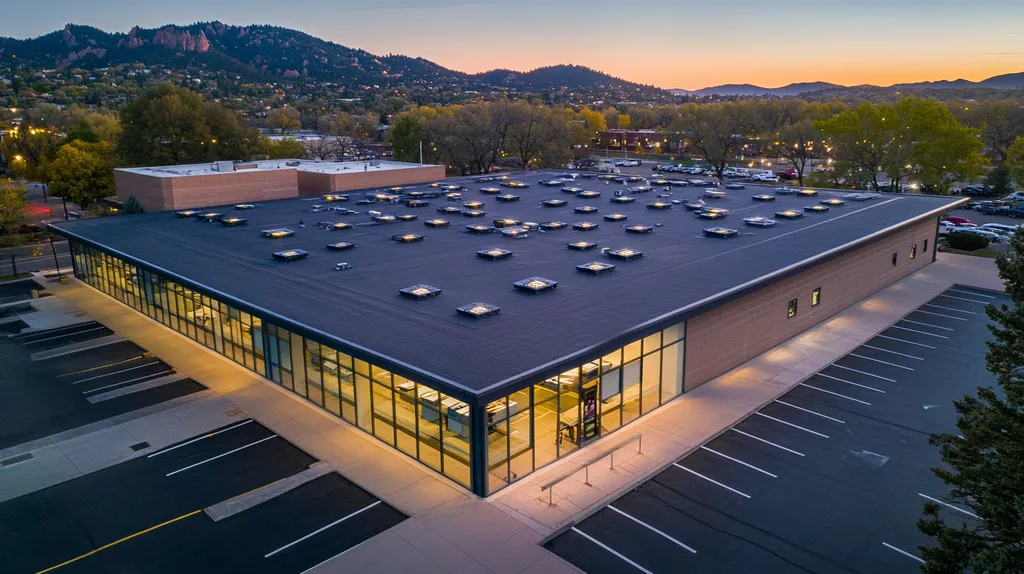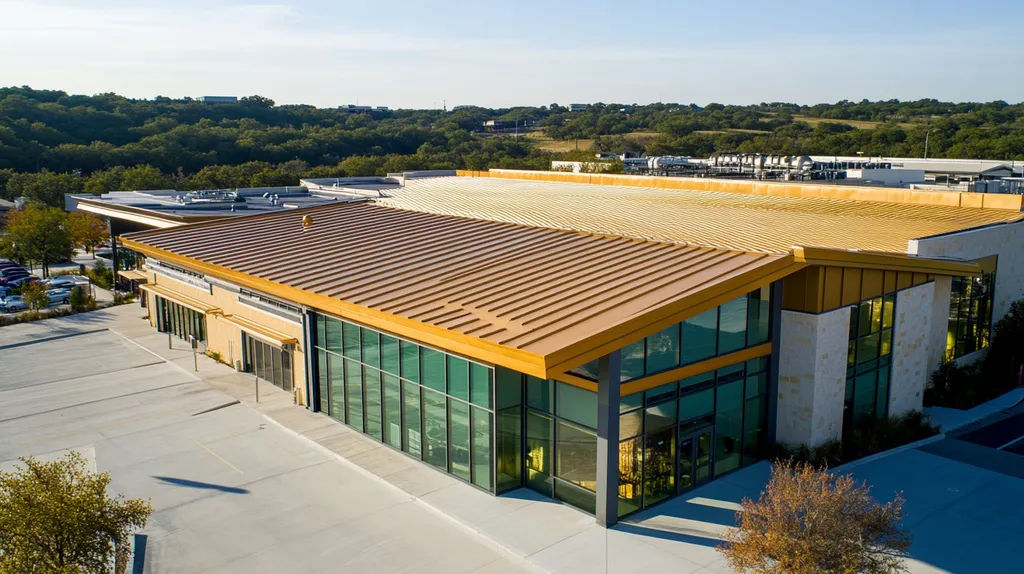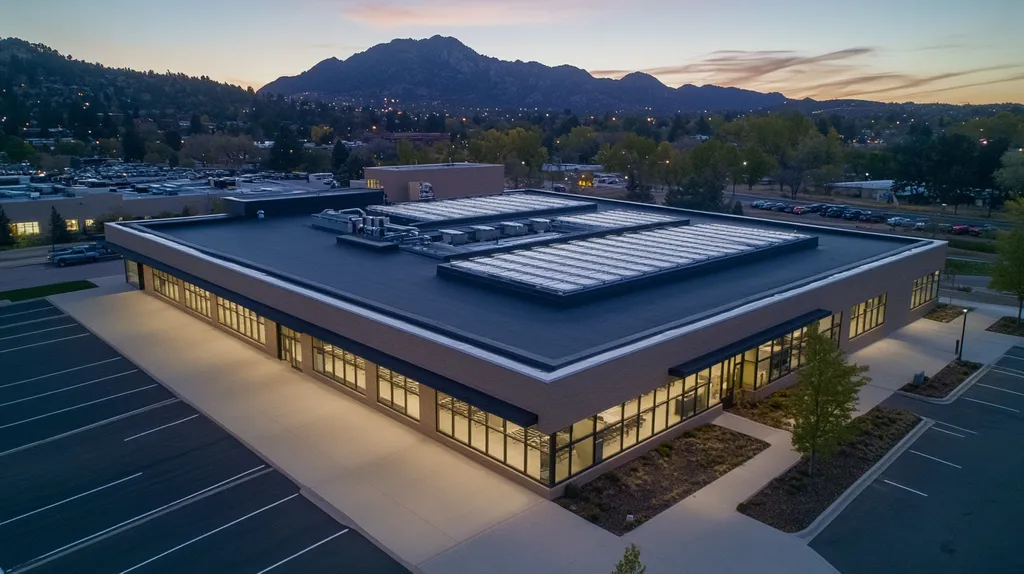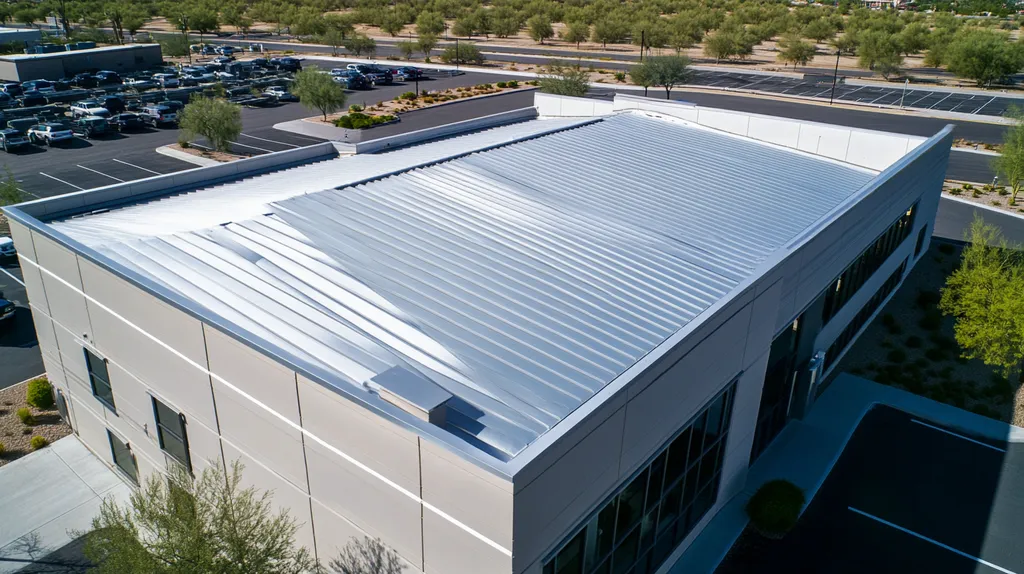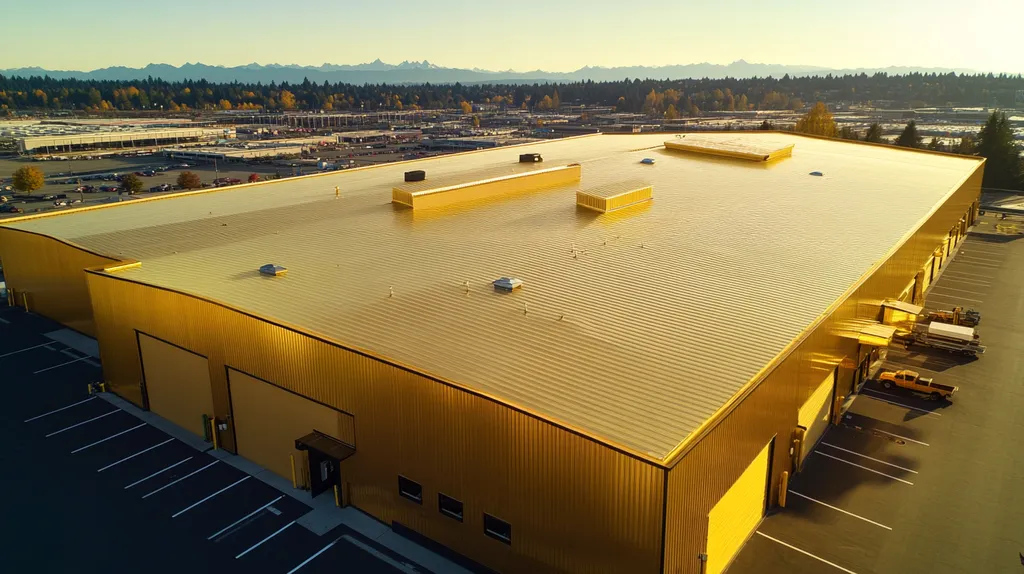Ventilation problems cost commercial building owners over $2 billion annually in premature roof failures, wasted energy, and structural damage. Recent industry studies show that 80% of commercial roofs have inadequate or improperly designed ventilation systems.
While ventilation directly impacts roof longevity and building efficiency, persistent myths continue driving costly mistakes in system design and maintenance. The consequences range from voided warranties to catastrophic structural failures.
This analysis examines common ventilation misconceptions, explores their practical and financial implications, and provides evidence-based solutions for optimizing commercial roof performance.
SECTION 1: COMMON MISCONCEPTIONS
Commercial roof ventilation problems cost building owners millions annually in premature repairs, energy waste, and structural damage. Understanding proper ventilation is critical for maintaining roof integrity and controlling operating costs. Yet persistent myths continue to drive poor decision-making around ventilation systems, leading to shortened roof lifespans and compromised building performance.
Myth: More Ventilation Always Improves Roof Performance
Proper ventilation plays a crucial role in reducing energy consumption and stabilizing roof temperatures. However, simply adding more vents without proper planning can create serious problems.
Excessive ventilation points can disrupt air pressure balance and create unwanted drafts. This imbalance often leads to higher energy costs as HVAC systems work harder to maintain interior temperatures.
Over-ventilation can also create condensation issues in unexpected areas of the roof assembly. When warm, moist air meets cooler surfaces in these spots, condensation forms and accelerates material deterioration.
The key is achieving balanced airflow based on your specific roof configuration and building use. A properly designed ventilation system mediates indoor temperatures while reducing reliance on heating and cooling systems. (source: Alpha Roofing)
Myth: Roof Vents Are Only Necessary in Warm Climates
Temperature regulation is just one function of roof ventilation. In cold climates, proper airflow prevents ice dam formation and manages moisture accumulation year-round.
During winter months, inadequate ventilation traps warm, humid air against the roof deck. This trapped moisture can saturate insulation and lead to rust, rot, and mold growth.
Cold climate buildings often experience greater temperature differentials between indoor and outdoor environments. Without proper ventilation, these differences create ideal conditions for condensation.
Seasonal changes in occupancy and usage patterns also impact ventilation needs. A system that works well in summer may be insufficient during peak heating seasons when indoor humidity levels rise.
Myth: Presence of Roof Vents Guarantees Proper Ventilation
Installing roof vents does not automatically ensure effective ventilation. The entire system must be properly designed, installed, and maintained to function as intended.
Blocked or improperly spaced vents fail to create the necessary air movement. Even minor obstructions can significantly reduce system effectiveness and create dead zones where problems develop.
Building modifications, such as adding walls or changing interior layouts, can disrupt established airflow patterns. These changes often require ventilation system adjustments to maintain performance.
Regular inspection and maintenance are essential to ensure vents remain unobstructed and functional. Dust, debris, and even bird nests can compromise ventilation effectiveness if not addressed promptly.
SECTION 2: PRACTICAL IMPLICATIONS
Commercial roofing systems face significant challenges when ventilation is improperly managed. Industry data shows that inadequate ventilation contributes to over 40% of premature roof failures and can reduce material lifespan by up to 50%. Understanding these implications is crucial for property owners and facility managers who must balance immediate costs against long-term performance.
Impact of Improper Ventilation on Moisture Control
Moisture accumulation represents one of the most destructive forces affecting commercial roofs. When ventilation systems fail to properly regulate airflow, trapped moisture can penetrate roofing materials and compromise structural integrity.
In commercial facilities, daily operations generate significant moisture through manufacturing processes, kitchen facilities, and human activity. Without adequate ventilation, this moisture becomes trapped within the roofing system, leading to material degradation.
Winter conditions particularly highlight ventilation deficiencies. Ice dam formation occurs when poor ventilation allows heat to escape through the roof, melting snow that later refreezes at the eaves.
The resulting damage often includes deteriorated insulation, compromised vapor barriers, and widespread mold growth. These issues compound over time, creating costly repair scenarios that could have been prevented through proper ventilation.
Ventilation’s Role in Energy Efficiency for Commercial Buildings
Proper attic ventilation creates cooler spaces in summer and drier conditions in winter, directly impacting a building’s energy consumption. The stack effect drives natural air movement, making balanced intake and exhaust vents essential for optimal performance.
Year-round ventilation benefits include reduced heat buildup and moisture levels, enhancing roof material longevity while supporting significant energy savings. This is particularly evident in cooling load reduction during hot weather and ice dam prevention during cold seasons.
Ventilation systems prove effective across various commercial building types and climates when properly designed and maintained. The key lies in maintaining consistent air pressure balance and temperature control throughout the roofing system.
By implementing proper ventilation strategies, buildings can achieve substantial reductions in heating and cooling costs while extending roof system life. (source: Asphalt Roofing Manufacturers Association)
Effects of Ventilation on Roof Longevity and Material Integrity
Material degradation accelerates dramatically when ventilation systems fail to maintain appropriate temperature and moisture levels. Excessive heat buildup can cause premature aging of roofing materials, while trapped moisture leads to decay and corrosion.
The impact extends beyond surface materials to affect underlying structural components. Deck boards can warp, fasteners may corrode, and insulation can lose its effectiveness when exposed to prolonged moisture exposure.
Many manufacturers now require specific ventilation requirements to maintain warranty coverage. Failure to meet these standards can void protection against material defects and premature failure.
Regular ventilation system inspections and maintenance help identify potential issues before they compromise roof integrity. This proactive approach proves far more cost-effective than addressing failures after they occur.
SECTION 3: COST OF MISINFORMATION
Poor ventilation practices drain millions from commercial property budgets annually through preventable damage and inefficiency. Recent industry data shows that ventilation-related roof failures typically cost businesses between $3-7 per square foot in repairs – expenses that could be avoided with proper understanding and implementation. Beyond immediate repair costs, misinformation about ventilation creates a cascade of problems affecting energy efficiency, structural integrity, and long-term maintenance expenses.
Financial Risks of Over- or Under-Ventilating Roof Systems
Too much or too little ventilation creates distinct financial vulnerabilities for commercial properties. Over-ventilation can compromise building envelope performance, leading to unnecessary heat loss in winter and increased cooling costs in summer.
Under-ventilation often results in accelerated material degradation, potentially reducing roof lifespan by 20-30%. This premature aging creates substantial replacement costs that could have been avoided with proper ventilation.
Too much or the wrong combination of roof ventilation can be just as damaging as insufficient airflow. When installed and functioning correctly, roof vents help maintain consistent temperatures and prevent costly moisture damage. (source: Angie’s List)
Insurance claims related to ventilation failures often face increased scrutiny, potentially leading to coverage disputes and unexpected out-of-pocket expenses for property owners.
Increased Maintenance and Repair Expenses from Ventilation Errors
Ventilation mistakes frequently manifest as recurring maintenance issues that drain operational budgets. Simple problems like blocked vents or improper spacing can cascade into system-wide failures requiring extensive repairs.
Material warranties may become void when ventilation specifications aren’t met, leaving building owners fully exposed to replacement costs. These warranty exclusions often surface only after significant damage has occurred.
Emergency repairs caused by ventilation failures typically cost 3-4 times more than planned maintenance. This premium reflects both the urgent nature of the work and the extensive damage that often develops before problems are detected.
The cumulative cost of deferred maintenance compounds when ventilation issues go unaddressed, often leading to more extensive structural repairs down the line.
Hidden Energy Costs Linked to Poor Ventilation Strategies
Improper ventilation creates significant but often overlooked energy waste through increased HVAC load. Buildings with ventilation problems typically see 15-25% higher heating and cooling costs compared to properly ventilated structures.
Poor airflow management forces mechanical systems to work harder and longer, leading to increased equipment wear and shortened system life. These indirect costs can equal or exceed direct repair expenses over time.
Temperature imbalances from inadequate ventilation create zones of inefficiency throughout the building. These hot and cold spots result in occupant discomfort and reduced productivity.
The combination of increased energy consumption and accelerated equipment wear creates a compounding cost burden that impacts both operational budgets and capital planning.
SECTION 4: REALITY CHECK
Commercial roof ventilation impacts every aspect of building performance, from energy efficiency to structural integrity. Industry data shows that improper ventilation reduces roof lifespans by up to 40% while increasing HVAC operating costs by 25-30%. Understanding the science behind ventilation, its year-round importance, and system design options helps property owners make informed decisions that protect their investment and control long-term costs.
Science Behind Optimal Ventilation Ratios and Airflow
Effective commercial roof ventilation depends on maintaining precise airflow ratios throughout the system. The standard baseline requires 1 square foot of net free ventilation area per 300 square feet of attic space, divided equally between intake and exhaust vents.
Pressure differentials drive air movement through the roof assembly. Higher pressure zones push air toward lower pressure areas, creating natural circulation that removes excess heat and moisture when properly balanced.
Temperature stratification within the roof cavity impacts ventilation effectiveness. Hot air rises and collects near the peak, making upper exhaust placement critical for removing heated air before it can damage roofing materials.
Airflow patterns vary based on building geometry, local climate, and internal conditions. These factors must be carefully analyzed when designing ventilation systems to ensure optimal performance.
Year-Round Importance of Ventilation in Different Climates
More roof ventilation is not necessarily better – proper balance matters most. When installed and functioning correctly, roof vents help maintain consistent temperatures while preventing moisture damage throughout all seasons.
In summer, effective ventilation can reduce peak roof deck temperatures by 30-40°F, significantly extending material lifespan. This temperature reduction also decreases cooling loads on HVAC systems.
Winter ventilation prevents ice dam formation by maintaining consistent roof surface temperatures. It also manages moisture that would otherwise condense and freeze within the roof assembly.
Proper ventilation proves equally important in humid climates where it helps prevent mold growth and wood rot by removing excess moisture year-round. (source: Angie’s List)
Common Ventilation System Designs and Their Effectiveness
Ridge vents provide continuous air exhaust along the roof peak, working with soffit vents to create consistent airflow. This passive system requires no energy input but depends on proper installation and maintenance.
Power ventilators actively remove hot air but require electricity and regular maintenance. Their effectiveness varies based on placement, capacity, and interaction with passive ventilation components.
Gable vents can supplement other systems but may short-circuit intended airflow patterns if improperly positioned. They work best when integrated into a comprehensive ventilation strategy.
Static vents and wind turbines offer targeted ventilation for specific roof areas. Their performance depends heavily on external conditions and proper spacing across the roof surface.
SECTION 5: EVIDENCE-BASED ALTERNATIVES
Commercial roof ventilation represents a critical yet frequently misunderstood building system that directly impacts operational costs and asset longevity. Industry data shows that improper ventilation can increase cooling costs by up to 30% while reducing roof material lifespan by decades. As building technologies evolve, evidence-based ventilation strategies have emerged that optimize performance through balanced airflow, climate-appropriate vent selection, and integrated insulation approaches.
Balanced Intake and Exhaust Ventilation Systems for Efficiency
Proper attic ventilation provides year-round benefits by creating cooler spaces in summer and drier conditions in winter, directly impacting building performance and energy consumption. In poorly ventilated buildings, attic temperatures can soar to 140°F on a 90°F day, accelerating material degradation.
Balanced intake and exhaust ventilation represents the most reliable method for managing the roof environment, requiring careful calculation of airflow ratios and vent placement. This approach helps preserve both roof materials and building structure while reducing energy costs. (source: Asphalt Roofing Manufacturers Association)
Modern ventilation systems incorporate pressure sensors and automated controls to maintain optimal airflow patterns throughout daily and seasonal changes. These smart systems adjust continuously to prevent both over-ventilation and dead zones.
Strategic placement of intake and exhaust points creates natural convection currents that move air efficiently without mechanical assistance. This passive approach reduces operational costs while maintaining consistent performance.
Selecting Vent Types Based on Building Design and Climate
Different commercial roof designs require specific ventilation approaches based on geometry, usage patterns, and local climate conditions. High-performance vent systems must account for these variables while maintaining consistent airflow throughout the roof assembly.
Static ridge vents paired with continuous soffit ventilation provide reliable performance across most building types. This combination creates predictable air movement patterns that effectively manage both temperature and moisture.
Power ventilators offer supplemental capacity for challenging conditions but require careful integration with passive systems. Strategic placement prevents short-circuiting while maximizing effectiveness during peak demand periods.
Climate-specific modifications help optimize performance in extreme conditions. These adaptations might include additional vapor barriers in humid regions or enhanced ice dam prevention features in cold climates.
Insulation and Air Sealing Complements to Ventilation
Effective ventilation requires proper insulation and air sealing to function as designed. These components work together to control heat flow and prevent unwanted air movement that could disrupt intended ventilation patterns.
Modern insulation systems incorporate vapor-permeable materials that complement ventilation while preventing condensation. This approach maintains thermal efficiency without trapping moisture within the roof assembly.
Strategic air sealing focuses on preventing random air leakage while maintaining designed ventilation pathways. This precision approach eliminates energy waste without compromising necessary airflow.
Regular monitoring of insulation condition and air barrier integrity ensures continued system effectiveness. Detection and repair of compromised areas prevents cascade failures that could impact overall roof performance.
SECTION 6: TEST AND VERIFY
Proactive testing and verification of commercial roof ventilation systems can prevent catastrophic failures that cost facility owners millions annually. Industry data shows that 80% of premature roof failures stem from undetected ventilation issues that could have been identified through proper inspection protocols. Without systematic verification, minor ventilation problems escalate into major structural damage, compromising both building integrity and operational budgets.
Methods to Measure Roof Ventilation Effectiveness
Digital manometers provide precise measurements of air pressure differentials across the roof assembly. These readings help identify areas where ventilation may be inadequate or improperly balanced.
Smoke testing reveals actual airflow patterns through the ventilation system. This visualization technique highlights dead zones, short circuits, and other flow disruptions that compromise system performance.
Data loggers strategically placed throughout the roof cavity track temperature and humidity levels over time. This continuous monitoring helps identify patterns and anomalies that indicate ventilation problems.
Wind speed indicators measure air movement at intake and exhaust points to verify proper flow rates. These measurements ensure ventilation components are performing to design specifications.
Using Thermal Imaging to Detect Moisture and Heat Loss
Infrared scanning reveals temperature variations that indicate ventilation failures, insulation gaps, and moisture infiltration. These scans provide detailed maps of problem areas before visible damage occurs.
Regular thermal imaging during peak heating and cooling seasons establishes performance baselines. Changes in thermal patterns over time help identify developing issues before they become critical.
Advanced imaging software analyzes temperature differentials to quantify energy losses. This data supports cost-benefit analysis for ventilation improvements and validates system performance.
Combined visual and thermal inspections create comprehensive documentation of roof conditions. This record-keeping proves invaluable for tracking system degradation and planning maintenance.
Guidelines for Routine Roof Ventilation Inspections and Audits
Monthly visual inspections should check for obvious blockages, damage, or deterioration of ventilation components. Even minor obstructions can significantly impact system performance if left uncorrected.
Quarterly performance testing measures airflow rates and pressure differentials throughout the ventilation system. These checks verify that all components maintain proper operation between major inspections.
Semi-annual comprehensive audits examine the entire ventilation system, including hidden components. These detailed evaluations often reveal developing problems that visual inspections might miss.
Documentation of all inspections creates an audit trail for warranty compliance and maintenance planning. This history helps identify patterns of failure and supports data-driven decisions about system improvements.
The Bottom Line
With over $2 billion lost annually to ventilation-related roof failures, building owners can no longer afford to ignore this critical system component.
The evidence clearly shows that proper commercial roof ventilation delivers measurable benefits: extended material lifespan, reduced energy costs, and protection from moisture damage.
Yet 80% of commercial roofs currently have suboptimal ventilation due to persistent myths and outdated practices.
Moving forward, facility managers must embrace evidence-based ventilation strategies, including balanced airflow systems, climate-appropriate vent selection, and regular performance verification.
The cost of inaction – in terms of premature roof failure, structural damage, and wasted energy – far exceeds the investment required to implement proper ventilation solutions.
FREQUENTLY ASKED QUESTIONS
Q. Does more ventilation always improve my commercial roof’s performance?
A. More ventilation isn’t always beneficial. Improperly designed systems can create excessive drafts and imbalance, leading to higher energy costs. Achieving balanced airflow tailored to your building is essential for efficient performance.
Q. How does poor ventilation impact my commercial roof’s moisture control?
A. Inadequate ventilation traps moisture, leading to material degradation and potential structural damage. This accumulation can cause rust, rot, and mold, which could result in costly repairs or even roof replacement.
Q. What are the financial risks of poor ventilation in my industrial roof?
A. Poor ventilation can lead to high repair costs, accelerated material wear, and increased energy expenses. Both over- and under-ventilation can financially strain your budget, potentially leading to significant unexpected expenses down the line.
Q. How much can improper ventilation reduce my commercial roof’s lifespan?
A. Improper ventilation can decrease roof lifespan by up to 40%. This degradation is caused by excessive heat and moisture accumulation, leading to serious financial and structural consequences for your building.
Q. What common ventilation system designs work for my commercial roof?
A. Common designs include ridge vents, soffit vents, and power ventilators. Each system varies in effectiveness based on installation, building shape, and local climate, requiring careful consideration and maintenance for optimal performance.
Q. How can I test if my commercial roof ventilation is effective?
A. Testing can include using digital manometers to measure air pressure, smoke testing to visualize airflow, and thermal imaging for heat and moisture detection. Regular inspections help identify and resolve ventilation problems early.
Q. What role does insulation play in my industrial roof’s ventilation?
A. Insulation and air sealing complement ventilation by controlling heat flow and preventing unwanted air movement. Strategically maintaining these elements ensures that your ventilation system operates effectively without energy waste or moisture issues.

